Transform your outdoor space into a neighborhood showstopper with these eleven breathtaking landscaping ideas that combine cutting-edge design trends with timeless elegance. In 2024, homeowners are moving beyond traditional lawn-and-shrub combinations to embrace dramatic elevation changes, sensory garden experiences, and luxury outdoor living spaces that serve as natural extensions of their homes [1]. These carefully curated landscaping concepts draw inspiration from the latest industry research, which reveals a 254% increase in searches for edible landscaping, a 77% surge in interest for fragrant plants like lavender, and a growing demand for outdoor spaces that provide both visual impact and functional living areas [1].
Explore these 11 Beautiful Landscaping Ideas to Make Your Neighbors Jealous, which can transform your outdoor space into a stunning environment.
The art of creating envy-inducing landscapes lies in understanding the psychological principles that make certain outdoor spaces irresistibly captivating. Professional landscape designers consistently emphasize the importance of layered visual interest, where multiple design elements work together to create depth, movement, and seasonal appeal that keeps neighbors stopping to admire your property throughout the year. Modern landscaping success depends on balancing dramatic focal points with cohesive design themes, incorporating sustainable practices that reduce maintenance while maximizing visual impact, and creating outdoor environments that reflect personal style while enhancing property value and neighborhood appeal.
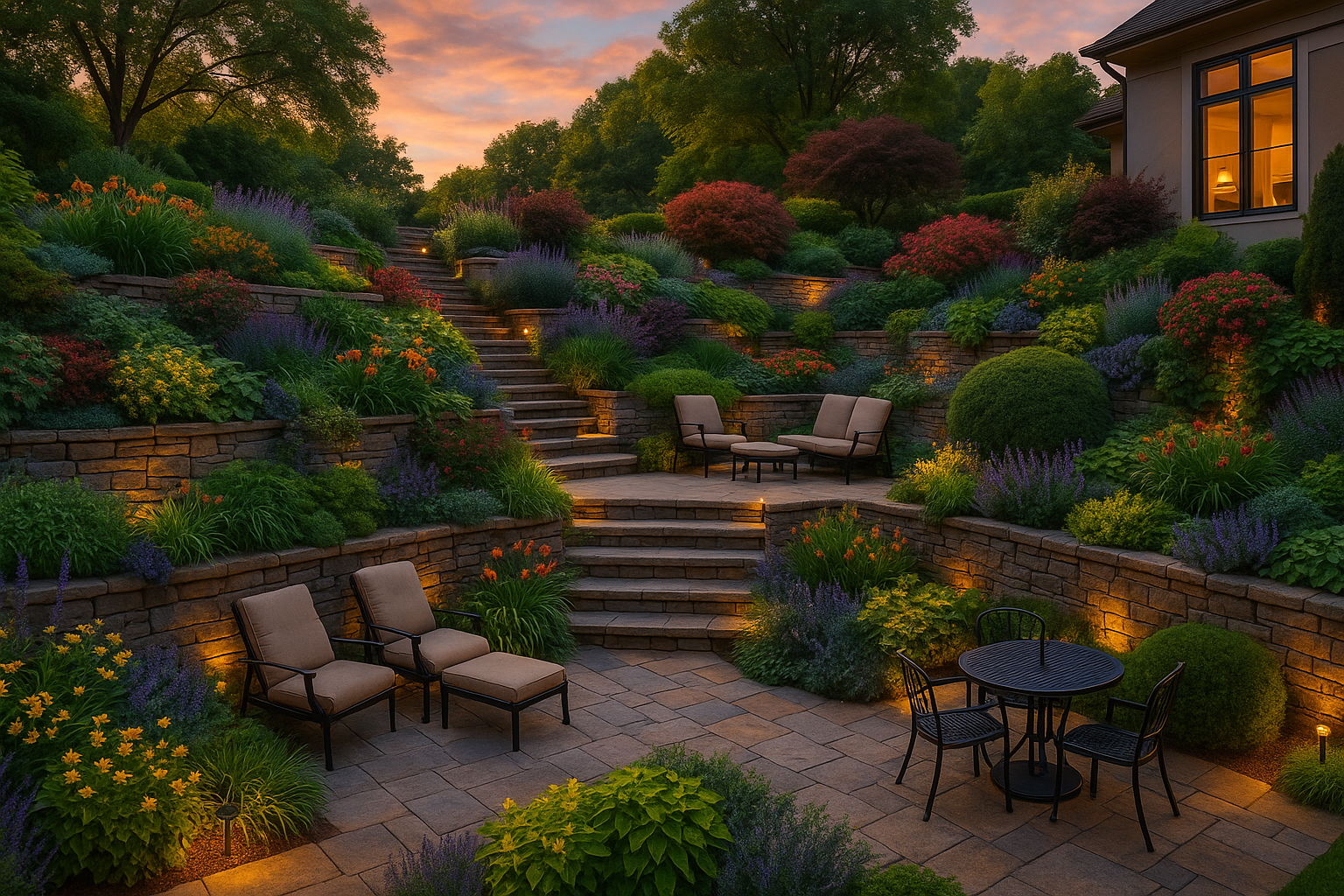
Implementing the 11 Beautiful Landscaping Ideas to Make Your Neighbors Jealous will elevate your landscape and inspire conversations.
These eleven landscaping ideas represent the pinnacle of contemporary outdoor design, each offering unique opportunities to showcase creativity, environmental consciousness, and sophisticated taste. From sunken garden retreats that create intimate outdoor rooms to vertical living walls that maximize growing space in minimal square footage, these concepts provide practical solutions for homeowners seeking to elevate their landscapes beyond the ordinary. Whether you’re working with a compact urban lot or an expansive suburban property, these professionally-inspired ideas can be adapted to suit various budgets, climates, and personal preferences while delivering the kind of stunning visual results that transform neighborhoods and inspire conversations.
1. Sunken Garden Sanctuaries: Creating Intimate Outdoor Rooms
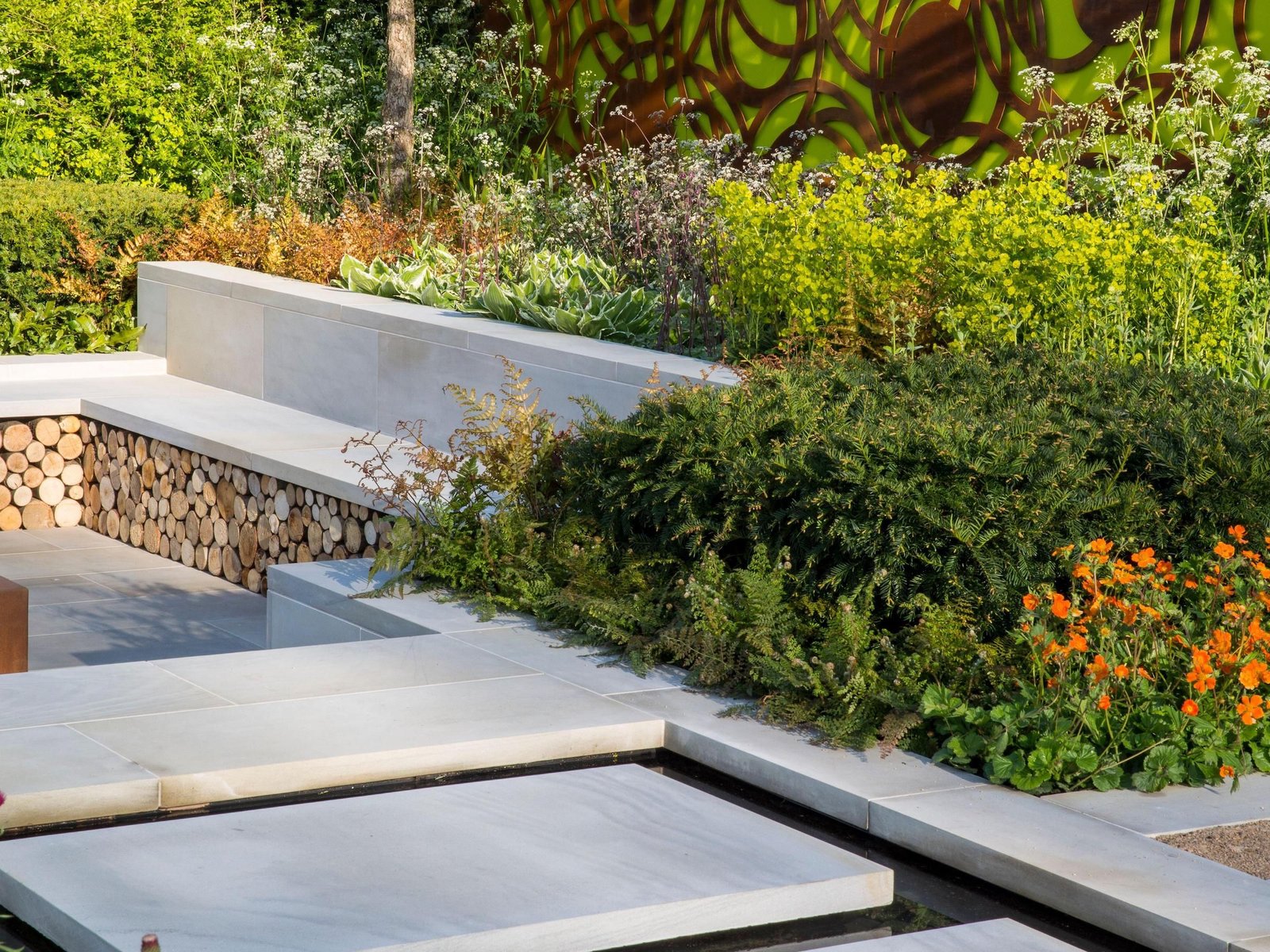
Sunken gardens represent the ultimate expression of sophisticated landscape architecture, creating intimate outdoor rooms that feel both secluded and dramatically impressive. These below-grade garden spaces offer a unique opportunity to establish distinct microclimates while providing natural windbreaks and enhanced privacy that makes outdoor entertaining more comfortable and appealing. The excavation required for sunken gardens allows for creative drainage solutions, enabling the incorporation of water features, specialized plant collections, and seating areas that feel naturally integrated into the landscape rather than imposed upon it.
The design possibilities for sunken gardens are virtually limitless, ranging from formal geometric layouts reminiscent of European estate gardens to naturalistic designs that mimic forest clearings or meadow depressions. Contemporary sunken garden designs often incorporate multiple levels within the excavated space, creating terraced planting areas that add vertical interest while maximizing growing space for diverse plant collections. The walls of sunken gardens provide excellent opportunities for incorporating built-in seating, storage, and lighting systems that enhance functionality while maintaining clean, uncluttered sight lines.
By integrating these 11 Beautiful Landscaping Ideas to Make Your Neighbors Jealous, you can create an outdoor sanctuary that stands out.
Professional landscape architects consistently recommend sunken gardens for properties with challenging topography, as these features can transform sloped or uneven terrain into stunning focal points that appear intentionally designed rather than problematic. The excavation process allows for the installation of sophisticated drainage systems, irrigation infrastructure, and electrical systems that support everything from subtle accent lighting to elaborate water features and outdoor audio systems. When properly designed and constructed, sunken gardens require less maintenance than traditional raised beds while providing superior growing conditions for plants that benefit from the protected microclimate and consistent moisture levels.
For homeowners interested in creating their own sunken garden sanctuary, the key considerations include proper drainage planning, soil amendment strategies, and plant selection that takes advantage of the unique growing conditions these spaces provide. The walls of sunken gardens can be constructed from various materials including natural stone, concrete blocks, or timber, with each option offering different aesthetic and functional benefits. Incorporating calming garden features such as water elements, fragrant plants, and comfortable seating transforms these spaces into true outdoor sanctuaries that provide respite from daily stresses while creating impressive focal points that neighbors will admire and envy.
2. Vertical Living Walls: Maximizing Impact in Minimal Space
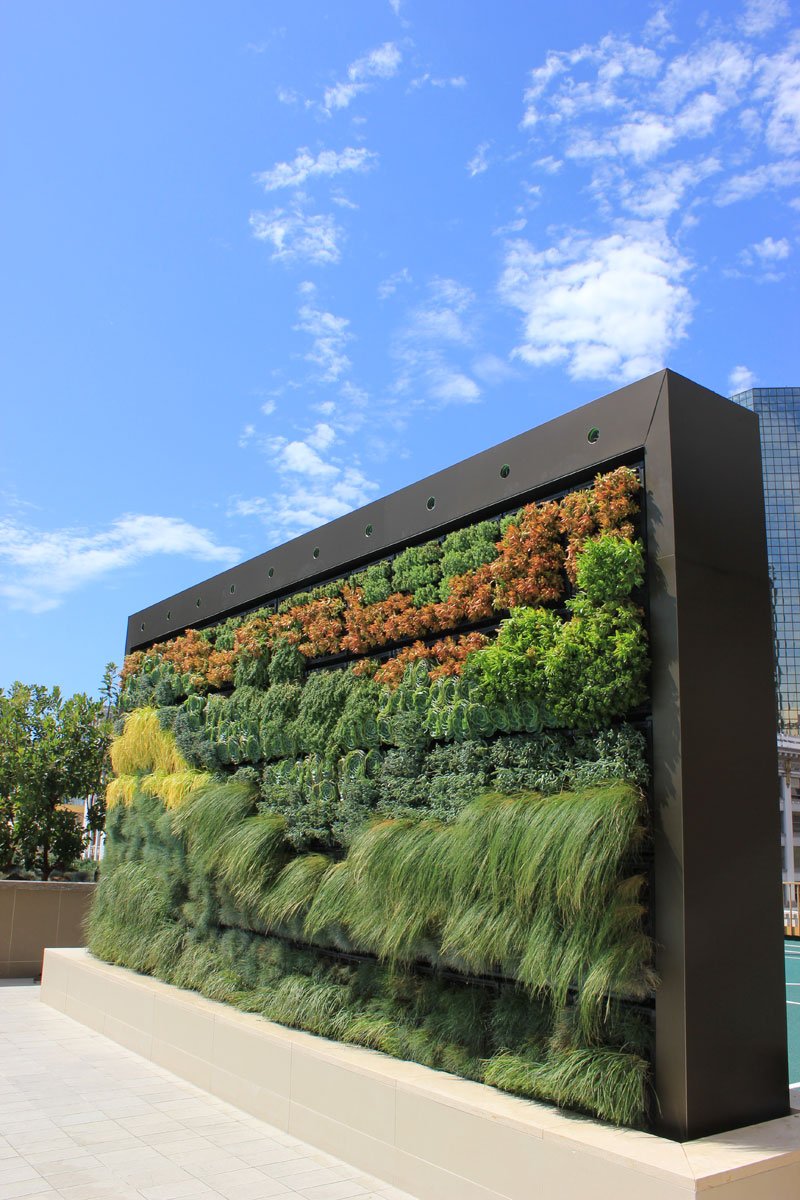
Vertical living walls have emerged as one of the most striking and space-efficient landscaping solutions for modern homeowners seeking maximum visual impact without requiring extensive horizontal space. These innovative installations transform blank walls, fences, and structural elements into lush, living artworks that provide year-round color, texture, and environmental benefits while creating stunning focal points that immediately capture attention and admiration. The technology behind modern living wall systems has advanced significantly, making these installations more accessible, sustainable, and maintainable for residential applications than ever before.
The environmental benefits of vertical living walls extend far beyond their aesthetic appeal, as these installations actively improve air quality, reduce urban heat island effects, and provide habitat for beneficial insects and birds. Research demonstrates that living walls can reduce ambient temperatures by up to 10 degrees Fahrenheit in their immediate vicinity while filtering pollutants and producing oxygen at rates that significantly exceed traditional horizontal plantings [2]. The insulation properties of living walls also contribute to energy savings by reducing heating and cooling costs for adjacent structures, making them both environmentally responsible and economically beneficial investments.
Modern living wall systems incorporate sophisticated irrigation, drainage, and plant support technologies that ensure consistent plant health while minimizing maintenance requirements. Automated irrigation systems can be programmed to deliver precise amounts of water and nutrients to individual plant zones, while integrated drainage systems prevent water damage to underlying structures. The modular nature of contemporary living wall systems allows for easy plant replacement, seasonal updates, and design modifications that keep these installations looking fresh and vibrant throughout the year.
Plant selection for vertical living walls requires careful consideration of factors including light exposure, wind conditions, weight limitations, and maintenance accessibility. Successful living wall designs typically incorporate a diverse mix of plants with varying textures, colors, and growth habits to create visual interest while ensuring that some plants will thrive regardless of seasonal variations or minor environmental changes. Popular plant choices include sedums, ferns, trailing varieties of herbs and vegetables, and compact flowering perennials that provide seasonal color without becoming too heavy or unwieldy for vertical support systems.
The installation of living walls can dramatically transform the perceived scale and character of outdoor spaces, making small courtyards feel more expansive while adding vertical interest to large, flat areas that might otherwise appear monotonous. When combined with strategic lighting, living walls become even more impressive, creating dramatic shadows and highlighting the textures and colors of the plantings during evening hours. For homeowners seeking to create soothing ambiance in outdoor gardens, living walls provide an excellent foundation for incorporating other calming elements such as water features, comfortable seating, and fragrant plants that engage multiple senses.
3. Multi-Level Terracing: Transforming Slopes into Stunning Landscapes
The art of terracing transforms challenging sloped terrain into spectacular multi-level landscapes that create dramatic visual impact while solving practical problems related to erosion control, water management, and usable outdoor space. Professional terracing projects demonstrate how thoughtful grading and retaining wall construction can convert previously unusable hillsides into functional outdoor living areas that rival the most impressive estate gardens. The key to successful terracing lies in understanding how different elevation levels can be designed to serve distinct purposes while maintaining visual cohesion throughout the entire landscape.
Contemporary terracing designs often incorporate a variety of materials and construction techniques to create visual interest while ensuring structural integrity and longevity. Natural stone retaining walls provide timeless elegance and excellent drainage characteristics, while modern concrete systems offer greater design flexibility and can be finished to mimic natural materials at lower costs. Timber terracing systems work particularly well in naturalistic settings and can be constructed using sustainable materials that age gracefully while providing excellent growing conditions for a wide variety of plants.
The planting design for terraced landscapes requires careful consideration of how different elevation levels affect growing conditions, with upper terraces typically receiving more sunlight and experiencing faster drainage than lower levels. This natural variation in microclimates provides opportunities to create diverse plant communities within a single landscape, with drought-tolerant plants thriving on upper levels while moisture-loving species flourish in lower terraces. The transition zones between different elevation levels offer excellent opportunities for incorporating seasonal interest through bulb plantings, ornamental grasses, and flowering perennials that provide color and texture throughout the growing season.
Water management becomes a crucial design element in terraced landscapes, as proper drainage prevents erosion while ensuring that each level receives appropriate moisture for optimal plant health. Sophisticated terracing projects often incorporate integrated irrigation systems that can be programmed to deliver different amounts of water to various elevation levels based on plant needs and environmental conditions. The incorporation of water features such as cascading streams or small pools between terraces adds both visual and auditory appeal while helping to manage stormwater runoff in environmentally responsible ways.
Lighting design plays a particularly important role in terraced landscapes, as strategic illumination can emphasize the dramatic elevation changes while ensuring safe navigation between different levels during evening hours. LED lighting systems integrated into retaining walls, steps, and planting areas create stunning nighttime displays that showcase the landscape’s architectural elements while providing practical illumination for outdoor entertaining and daily use. The combination of terraced plantings, water features, and sophisticated lighting creates outdoor environments that appear professionally designed and maintained, generating the kind of neighborhood admiration that makes property values soar.
4. Statement Water Features: Creating Focal Points That Demand Attention
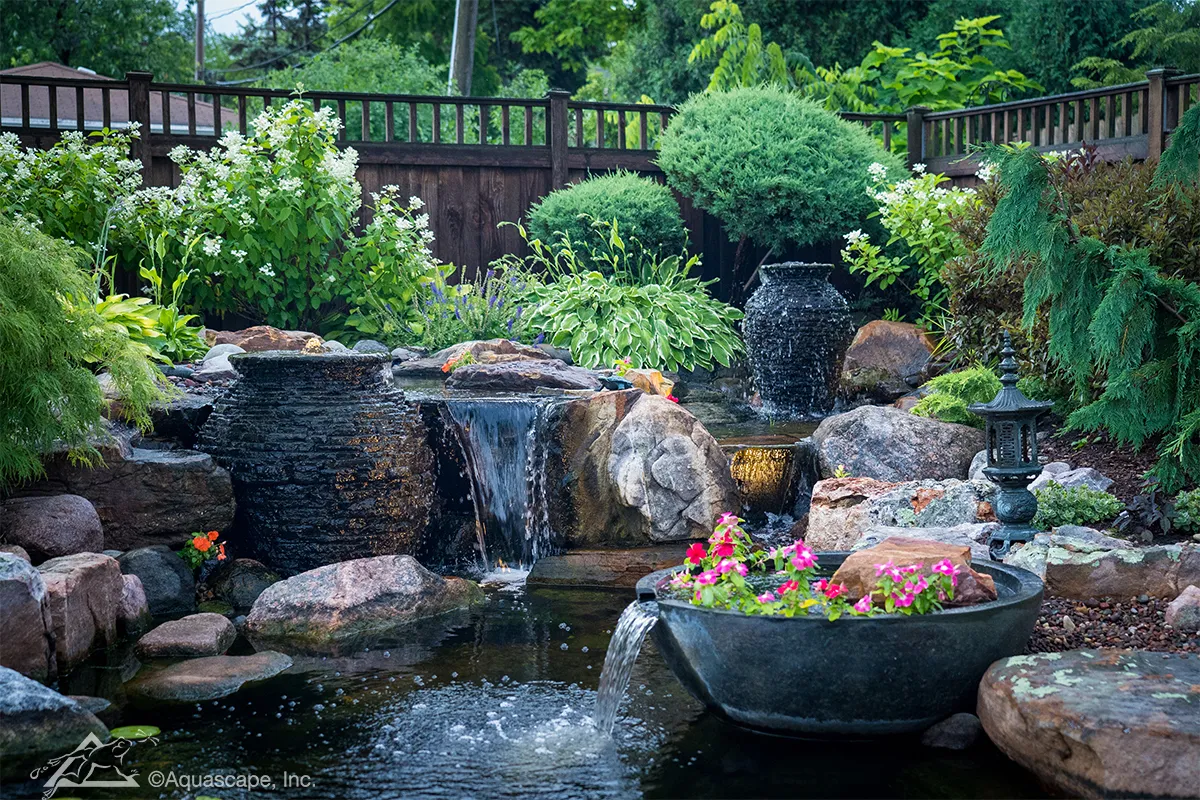
Statement water features serve as the crown jewels of impressive landscapes, providing both visual drama and soothing sounds that transform ordinary outdoor spaces into resort-like environments that neighbors can’t help but admire. The psychology of water in landscape design taps into fundamental human responses to natural elements, creating immediate feelings of tranquility and luxury that make outdoor spaces more inviting and memorable. Modern water feature technology has evolved to offer homeowners unprecedented options for incorporating everything from subtle bubbling fountains to dramatic cascading waterfalls that serve as commanding focal points for entire landscape designs.
The selection of appropriate water features depends on factors including available space, existing landscape style, maintenance preferences, and budget considerations, with options ranging from simple container water gardens to elaborate multi-tiered fountain systems that incorporate lighting, music, and automated controls. Contemporary water feature designs often emphasize clean, geometric lines that complement modern architectural styles, while naturalistic designs mimic streams, ponds, and waterfalls that appear to have occurred naturally within the landscape. The integration of water features with surrounding plantings creates opportunities for developing specialized plant communities that thrive in moist conditions while providing additional visual interest and habitat for wildlife.
Professional water feature installations incorporate sophisticated filtration, circulation, and maintenance systems that ensure crystal-clear water while minimizing ongoing care requirements. Modern pump and filtration technologies allow for the creation of elaborate water displays that operate efficiently and reliably, with many systems incorporating smart controls that can be managed remotely via smartphone applications. The addition of underwater lighting transforms water features into stunning nighttime displays that extend the visual impact of these installations well beyond daylight hours, creating dramatic focal points that enhance outdoor entertaining and property security.
The sound characteristics of different water feature designs provide opportunities to create specific acoustic environments that mask unwanted noise while promoting relaxation and conversation. Gentle bubbling fountains provide subtle background sounds that enhance intimate seating areas, while more dramatic cascading features create stronger acoustic presence that can effectively mask traffic noise or other urban sounds. The positioning of water features within the landscape affects both their visual and acoustic impact, with centrally located features serving as focal points for entire outdoor spaces while perimeter installations can create privacy screens and boundary definitions.
Maintenance considerations for statement water features include regular cleaning, seasonal preparation, and occasional equipment servicing, with most modern systems designed to minimize these requirements through automated controls and self-cleaning technologies. The incorporation of aquatic plants and beneficial bacteria helps maintain water quality naturally while adding biological interest to water features. For homeowners seeking to create comprehensive outdoor environments that promote mental health benefits through gardening, water features provide excellent foundations for developing therapeutic landscapes that engage multiple senses while providing opportunities for quiet contemplation and stress relief.
5. Outdoor Living Rooms: Luxury Entertaining Spaces
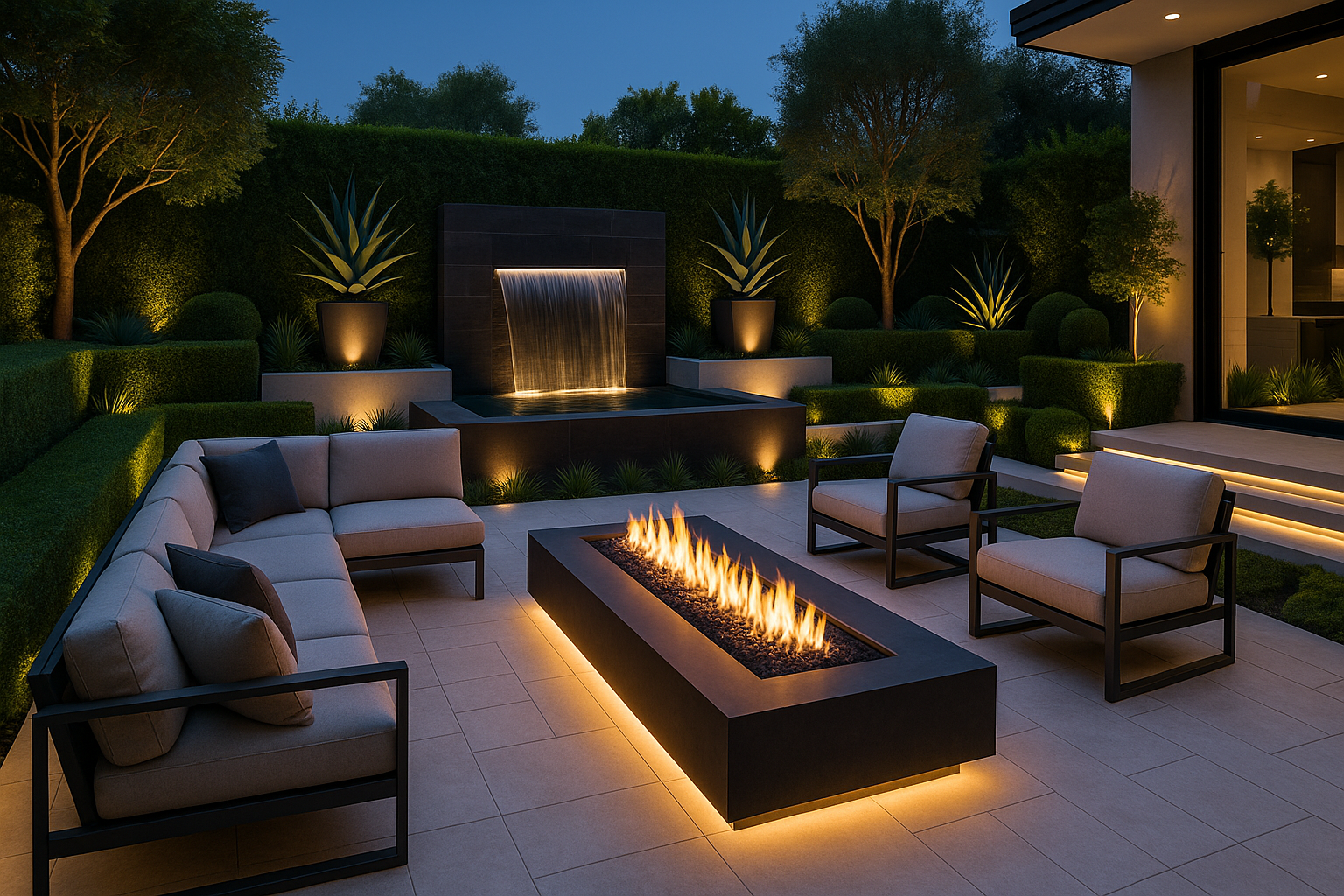
The concept of outdoor living rooms has revolutionized residential landscape design by creating seamless transitions between indoor and outdoor spaces that provide all the comfort and functionality of interior rooms while taking advantage of natural settings and fresh air. These sophisticated outdoor environments incorporate high-quality furniture, weather-resistant materials, and integrated systems for lighting, heating, and entertainment that make year-round outdoor living both practical and luxurious. The key to successful outdoor living room design lies in understanding how to balance comfort, durability, and style while creating spaces that feel naturally integrated into the surrounding landscape.
Contemporary outdoor living room designs often feature modular furniture systems that can be reconfigured for different activities and group sizes, with materials selected for their ability to withstand weather exposure while maintaining attractive appearances over time. High-performance fabrics, powder-coated metals, and engineered materials provide the durability necessary for outdoor use while offering the comfort and aesthetic appeal expected in luxury interior spaces. The incorporation of outdoor kitchens, bars, and dining areas extends the functionality of these spaces while creating opportunities for elaborate entertaining that rivals the most impressive indoor venues.
Climate control systems for outdoor living rooms have become increasingly sophisticated, with options including radiant heating systems integrated into flooring and seating, overhead heating elements that provide targeted warmth, and misting systems that cool spaces during hot weather. Fire features serve dual purposes as both heating elements and dramatic focal points, with modern designs ranging from sleek linear fire tables to elaborate fire bowls that create gathering points for conversation and relaxation. The integration of these climate control systems with smart home technologies allows for precise environmental control that ensures comfort regardless of weather conditions.
Lighting design plays a crucial role in creating outdoor living rooms that function effectively during evening hours while providing the ambiance necessary for successful entertaining. Layered lighting systems incorporate ambient, task, and accent lighting to create flexible environments that can be adjusted for different activities and moods. LED technologies offer energy-efficient solutions that provide excellent color rendering while minimizing heat generation and maintenance requirements. The integration of lighting controls with smart home systems allows for sophisticated programming that can create different lighting scenes for various occasions and times of day.
Privacy considerations become particularly important for outdoor living rooms, as these spaces are designed for relaxation and entertaining that may require screening from neighboring properties. Living fences created from carefully selected and maintained plantings provide natural privacy screens that enhance rather than detract from the overall landscape design. The strategic placement of trees, large shrubs, and architectural elements can create intimate spaces that feel secluded while maintaining visual connections to other areas of the landscape. For homeowners interested in developing comprehensive backyard garden layouts that incorporate outdoor living spaces, professional design assistance can help ensure that these areas integrate seamlessly with existing landscape features while providing the functionality and visual impact necessary to create truly impressive outdoor environments.
6. Sculptural Garden Art: Integrating Artistic Elements
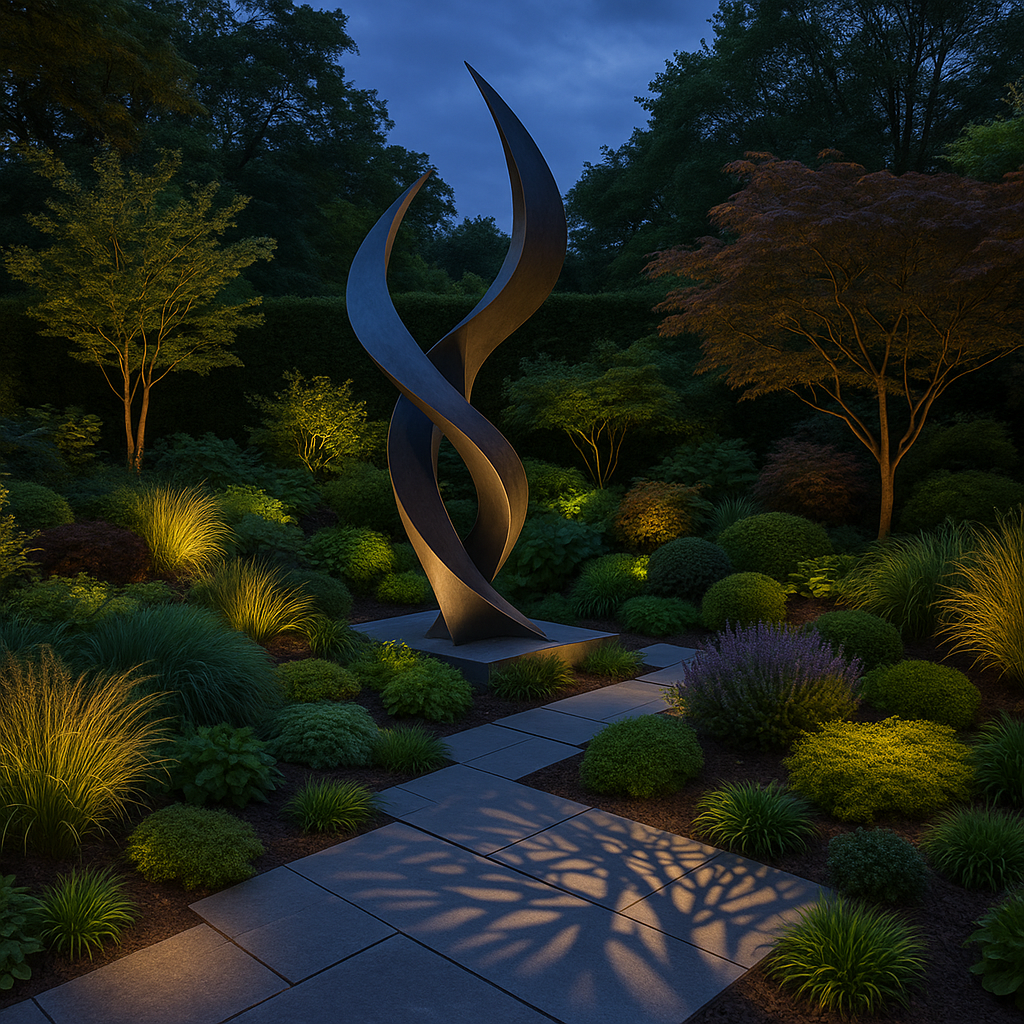
The integration of sculptural elements into landscape designs creates opportunities for personal expression while establishing dramatic focal points that elevate ordinary gardens into extraordinary outdoor art galleries. Contemporary garden sculpture encompasses a vast range of styles, materials, and scales, from subtle abstract pieces that complement naturalistic plantings to bold contemporary works that command attention and spark conversation. The key to successful sculpture integration lies in understanding how artistic elements can enhance rather than compete with natural landscape features while creating visual anchors that provide structure and interest throughout the seasons.
Professional landscape designers consistently emphasize the importance of scale relationships when incorporating sculptural elements, as pieces that are too small may be overwhelmed by surrounding plantings while oversized works can dominate spaces in ways that feel uncomfortable or unbalanced. The positioning of sculptures within the landscape affects both their visual impact and their relationship to viewing areas, with successful installations creating sight lines that draw visitors through the garden while revealing different perspectives of both artistic and natural elements. The interplay between sculpture and plantings creates opportunities for seasonal changes that keep garden displays fresh and engaging throughout the year.
Material selection for garden sculpture involves considerations including weather resistance, maintenance requirements, and aesthetic compatibility with surrounding landscape elements. Traditional materials such as bronze, stone, and ceramic offer timeless appeal and excellent durability, while contemporary options including stainless steel, corten steel, and composite materials provide opportunities for more experimental designs that may better complement modern architectural styles. The patina and weathering characteristics of different materials contribute to their long-term aesthetic appeal, with some pieces becoming more beautiful as they age and develop natural surface treatments.
Lighting design becomes particularly important when incorporating sculptural elements, as strategic illumination can dramatically enhance the visual impact of artistic pieces while creating stunning nighttime displays that extend the garden’s appeal beyond daylight hours. Uplighting, backlighting, and accent lighting techniques can emphasize different aspects of sculptural works while creating dramatic shadows and highlighting textural details that may not be apparent during daylight viewing. The integration of lighting controls allows for different illumination schemes that can be adjusted for various occasions and seasonal changes.
The selection of appropriate sculptural elements requires consideration of personal taste, landscape style, and long-term maintenance commitments, with successful installations reflecting the homeowner’s personality while enhancing the overall garden design. Abstract pieces often work well in diverse landscape settings as they complement rather than compete with natural elements, while representational works may be more appropriate for formal garden designs or specialized theme areas. The incorporation of water features, specialized plantings, and architectural elements around sculptural installations creates comprehensive design vignettes that showcase artistic pieces while integrating them seamlessly into the broader landscape composition.
For homeowners seeking to create gardens that provide both visual impact and personal meaning, sculptural elements offer excellent opportunities to express individual creativity while establishing focal points that generate neighborhood admiration and conversation. The combination of artistic elements with thoughtfully designed plantings creates outdoor environments that function as both gardens and galleries, providing year-round interest and beauty that enhances property values while reflecting sophisticated design sensibilities.
7. Sensory Gardens: Engaging All Five Senses
The development of sensory gardens represents a sophisticated approach to landscape design that creates immersive outdoor experiences engaging sight, sound, smell, touch, and even taste through carefully selected plants and design elements. Research indicates that sensory gardens provide significant therapeutic benefits while creating memorable outdoor environments that appeal to visitors of all ages and abilities [1]. The key to successful sensory garden design lies in understanding how different plants and materials can stimulate various senses while creating cohesive compositions that feel naturally integrated rather than artificially constructed.
Fragrant plants form the foundation of most sensory gardens, with selections including traditional favorites such as lavender, rosemary, and mint alongside more unusual aromatic species that provide unique scent experiences throughout the growing season. The strategic placement of fragrant plants near seating areas, pathways, and gathering spaces ensures that visitors encounter pleasant aromas during normal garden activities while creating opportunities for more intentional sensory experiences. The timing of different plant fragrances throughout the day and season adds temporal dimensions to sensory gardens that keep these spaces interesting and engaging over time.
Textural elements in sensory gardens provide opportunities for tactile experiences that add depth and interest to garden visits while accommodating visitors with visual impairments or other accessibility needs. Plants with distinctive textures including soft lamb’s ear, spiky ornamental grasses, and smooth succulent leaves create natural opportunities for hands-on exploration that enhances the garden experience. The incorporation of different hardscape materials including smooth river rocks, rough bark mulches, and polished stone surfaces adds additional textural variety while providing practical benefits such as drainage and weed suppression.
Sound elements in sensory gardens can include both natural and artificial components that create acoustic environments supporting relaxation and contemplation. The rustling of ornamental grasses and bamboo provides gentle natural sounds that change with wind conditions, while water features add consistent acoustic backgrounds that mask unwanted noise while promoting tranquility. Wind chimes, bells, and other sound-producing elements can be strategically placed to create interactive opportunities that allow visitors to create their own acoustic experiences within the garden setting.
Visual elements in sensory gardens often emphasize color, movement, and seasonal change rather than static displays, with plant selections chosen for their ability to provide ongoing interest through flowering, fruiting, and foliage changes. The incorporation of plants that attract butterflies, hummingbirds, and other wildlife adds dynamic visual elements that create constantly changing displays throughout the growing season. Evening-blooming plants and those with distinctive nighttime fragrances extend the sensory garden experience into twilight hours while providing opportunities for different types of garden experiences.
The integration of edible plants into sensory gardens adds taste experiences while providing practical benefits that make these spaces more functional and engaging for families. Herb gardens, berry patches, and fruit trees can be incorporated into sensory garden designs in ways that provide both ornamental and culinary value while creating opportunities for hands-on gardening experiences that enhance the connection between visitors and the natural world. For homeowners interested in developing comprehensive therapeutic landscapes, sensory gardens provide excellent foundations for creating zen garden environments that promote relaxation and mindfulness while providing the visual impact necessary to create neighborhood admiration.
8. Living Fences and Privacy Screens: Natural Boundaries with Style
The concept of living fences has gained tremendous popularity as homeowners seek alternatives to traditional fencing that provide privacy and boundary definition while enhancing rather than detracting from landscape aesthetics. Living fences created from carefully selected and maintained plants offer numerous advantages over conventional fencing including improved wildlife habitat, better environmental integration, and the ability to provide seasonal interest through flowering, fruiting, and foliage changes. The key to successful living fence design lies in selecting appropriate plant species that will thrive in local growing conditions while providing the desired screening characteristics and visual appeal.
Contemporary living fence designs often incorporate mixed plantings that provide year-round screening while offering seasonal variety through different flowering times, foliage colors, and growth habits. Evergreen species form the backbone of most living fences as they provide consistent screening throughout the year, while deciduous plants add seasonal interest and may provide better growing conditions for understory plantings during winter months when they are leafless. The layering of different plant heights and textures creates more interesting and effective screening while providing habitat diversity that supports beneficial wildlife populations.
Maintenance requirements for living fences vary significantly depending on plant selections and desired appearance, with formal hedge-style installations requiring regular pruning and shaping while naturalistic mixed plantings may need only occasional selective pruning and plant replacement. The establishment period for living fences typically requires more intensive care including regular watering, fertilization, and pest management, but mature installations often require less maintenance than traditional fencing while providing superior environmental benefits and aesthetic appeal.
The integration of living fences with other landscape elements creates opportunities for developing comprehensive privacy solutions that address multiple design objectives simultaneously. The incorporation of seating areas, water features, and specialty plantings within or adjacent to living fence installations creates outdoor rooms that feel naturally enclosed while maintaining visual connections to other areas of the property. Strategic openings in living fences can frame views of particularly attractive landscape features while maintaining overall privacy and boundary definition.
Plant selection for living fences requires consideration of factors including mature size, growth rate, maintenance requirements, and compatibility with local growing conditions and climate patterns. Fast-growing species provide quicker screening but may require more frequent maintenance, while slower-growing plants often provide better long-term structure and may be more appropriate for formal installations. The incorporation of flowering and fruiting plants into living fence designs adds seasonal interest while providing food sources for wildlife and opportunities for homeowner enjoyment.
For properties with challenging site conditions including poor soil, limited water availability, or extreme weather exposure, specialized plant selections and installation techniques may be necessary to ensure living fence success. Soil amendment, irrigation system installation, and wind protection during establishment can significantly improve the success rate of living fence projects while reducing long-term maintenance requirements. The combination of living fences with complementary landscape features creates comprehensive outdoor environments that provide privacy, beauty, and environmental benefits while generating the kind of neighborhood admiration that makes properties stand out from surrounding developments.
9. Seasonal Color Rotation Gardens: Year-Round Visual Interest
The development of seasonal color rotation gardens represents an advanced approach to landscape design that ensures continuous visual interest throughout the year while creating dynamic displays that change dramatically with the seasons. These sophisticated planting schemes require careful planning and plant selection to ensure that different areas of the garden reach peak display at various times, creating a constantly evolving landscape that provides new discoveries and experiences throughout the growing season. The key to successful seasonal rotation gardens lies in understanding the blooming times, foliage characteristics, and growth habits of diverse plant species while creating compositions that maintain visual appeal even during transition periods.
Spring color rotation gardens typically emphasize bulb plantings, early-flowering trees and shrubs, and cool-season annuals that provide dramatic displays after the dormancy of winter months. The strategic placement of spring-flowering plants near outdoor living areas and primary viewing locations ensures maximum impact during the season when homeowners are most eager to spend time outdoors after winter confinement. The incorporation of fragrant spring bloomers such as lilacs, mock orange, and flowering fruit trees adds sensory dimensions to seasonal displays while creating memorable garden experiences that mark the transition from winter to growing season.
Summer color rotation gardens focus on heat-tolerant plants that provide continuous blooming through the challenging conditions of mid-summer, with selections including both annual and perennial species that offer different maintenance requirements and visual characteristics. The layering of different plant heights and bloom times creates succession plantings that ensure continuous color even as individual species complete their flowering cycles. The incorporation of foliage plants with distinctive colors and textures provides visual interest during periods when flowering may be less abundant while creating backgrounds that enhance the impact of blooming plants.
Fall color rotation gardens capitalize on the natural tendency of many plants to produce their most dramatic displays during autumn months, with selections including trees and shrubs known for exceptional fall foliage as well as late-blooming perennials that provide color when most other plants are preparing for dormancy. The strategic placement of fall-interest plants creates focal points that draw attention to different areas of the garden throughout the autumn season while providing opportunities for seasonal decorating and outdoor entertaining during comfortable fall weather.
Winter interest in seasonal rotation gardens comes from plants with distinctive bark, persistent fruits, interesting branching patterns, and evergreen foliage that provide structure and visual appeal during the dormant season. The incorporation of ornamental grasses, seed heads from perennial plants, and plants with colorful winter stems creates textural interest that can be enhanced by frost and snow while providing food sources for wildlife during challenging winter months. Strategic lighting can dramatically enhance winter garden displays while extending the visual impact of seasonal plantings into evening hours.
The maintenance of seasonal color rotation gardens requires ongoing attention to plant health, soil conditions, and succession planting schedules that ensure continuous displays throughout the growing season. The incorporation of automated irrigation systems, soil amendment programs, and integrated pest management strategies helps maintain optimal growing conditions while minimizing the labor required to keep these sophisticated plantings looking their best. For homeowners seeking to create landscapes that provide constant visual interest while demonstrating advanced gardening knowledge and commitment, seasonal color rotation gardens offer excellent opportunities to showcase horticultural expertise while creating outdoor environments that generate consistent neighborhood admiration and conversation.
10. Edible Landscaping: Beautiful and Functional Gardens
The integration of edible plants into ornamental landscape designs creates outdoor environments that provide both visual appeal and practical benefits while demonstrating environmental consciousness and self-sufficiency values that resonate with contemporary homeowners. Edible landscaping represents a sophisticated approach to garden design that challenges traditional distinctions between ornamental and utilitarian plantings while creating opportunities for hands-on gardening experiences that connect families with food production and seasonal cycles. The key to successful edible landscaping lies in selecting plants that provide both ornamental value and culinary utility while creating compositions that maintain visual appeal throughout the growing season.
Contemporary edible landscape designs often emphasize the ornamental characteristics of food plants, showcasing the beautiful flowers of fruit trees, the architectural forms of vegetable plants, and the textural interest of herb gardens in ways that rival traditional ornamental plantings. The strategic placement of edible plants throughout the landscape creates opportunities for casual harvesting during normal garden activities while ensuring that productive areas receive appropriate sunlight, water, and soil conditions for optimal growth and yield. The integration of edible plants with purely ornamental species creates diverse plant communities that provide habitat for beneficial insects while reducing pest problems through natural biological controls.
Fruit tree integration into landscape designs provides opportunities for creating dramatic focal points that offer seasonal interest through flowering, fruiting, and fall color while providing valuable food crops that can significantly reduce grocery expenses. Dwarf and semi-dwarf fruit varieties work particularly well in residential landscapes as they provide manageable sizes while offering full-sized fruit production. The espaliered training of fruit trees against walls, fences, and trellises creates living artwork that maximizes production in minimal space while providing distinctive architectural elements that enhance property values and neighborhood appeal.
Herb garden integration into landscape designs creates opportunities for developing specialized garden areas that provide both culinary and medicinal plants while offering distinctive fragrances, textures, and visual characteristics that enhance overall garden appeal. The placement of herb gardens near outdoor kitchens, dining areas, and frequently used pathways ensures convenient access for cooking while creating sensory experiences that enhance outdoor living. Many culinary herbs provide excellent ornamental value through distinctive foliage colors, interesting growth habits, and attractive flowering displays that rival traditional ornamental plants.
Vegetable garden integration into landscape designs requires careful consideration of seasonal changes, space requirements, and maintenance needs while creating compositions that maintain visual appeal even during harvest periods and seasonal transitions. The use of raised beds, container plantings, and structured garden layouts helps integrate vegetable production into ornamental landscapes while providing optimal growing conditions and easier maintenance access. The incorporation of trellises, arbors, and other support structures for climbing vegetables creates vertical interest while maximizing production in limited space.
The maintenance of edible landscapes requires attention to soil health, pest management, and harvest scheduling while maintaining the visual standards expected in ornamental garden settings. Organic growing practices become particularly important in edible landscapes as they ensure food safety while promoting environmental health and beneficial wildlife populations. The integration of composting systems, rainwater collection, and other sustainable practices enhances the environmental benefits of edible landscaping while reducing ongoing maintenance costs and resource requirements. For homeowners seeking to create landscapes that demonstrate environmental consciousness while providing practical benefits and visual appeal, edible landscaping offers excellent opportunities to showcase sustainable living practices while creating outdoor environments that generate neighborhood admiration and inspire others to adopt similar approaches.
11. Smart Lighting Design: Illuminating Your Landscape’s Best Features
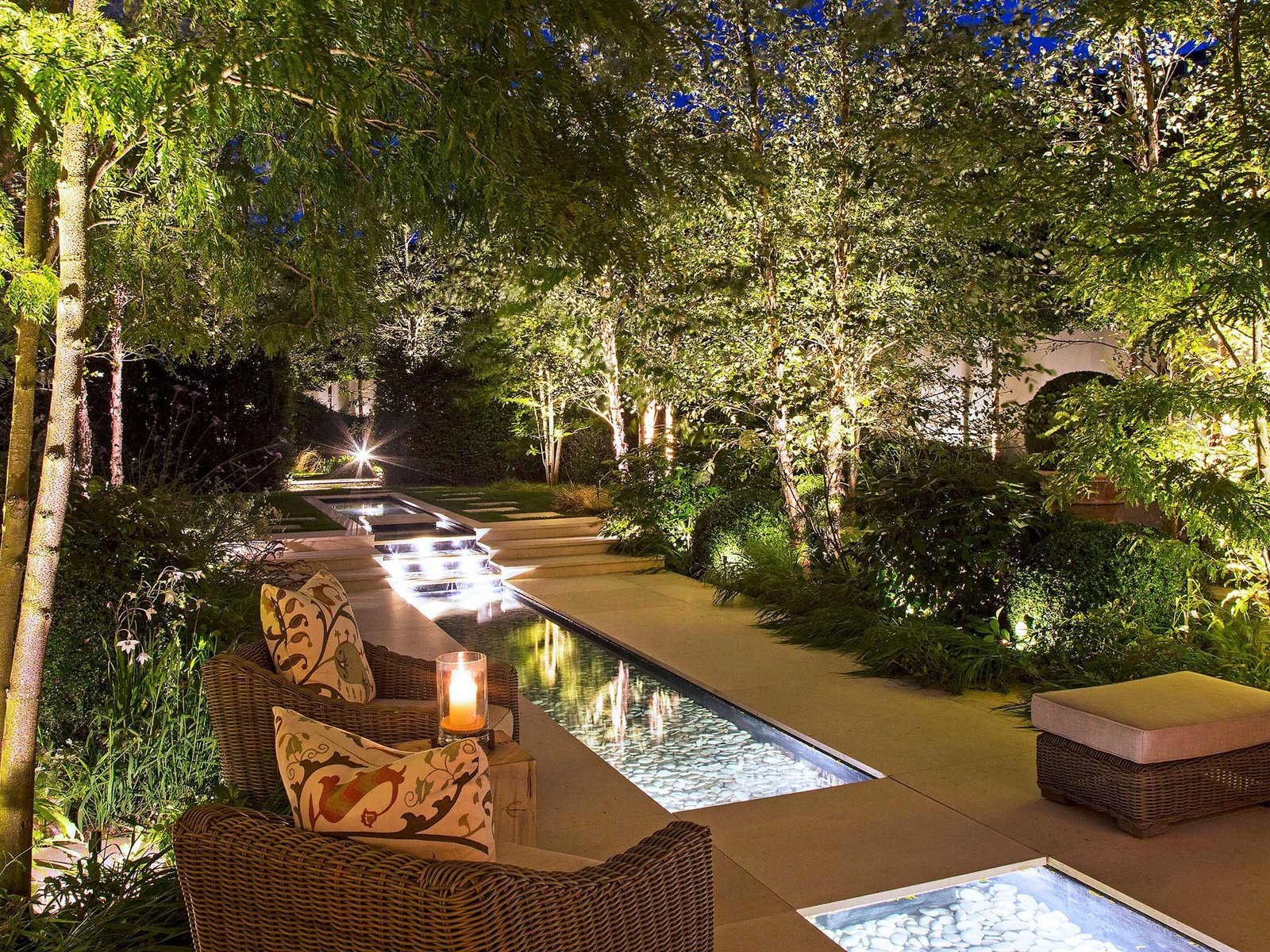
Professional landscape lighting design transforms outdoor spaces into stunning nighttime displays that extend the usability and visual impact of gardens well beyond daylight hours while providing essential safety and security benefits. Contemporary lighting technologies offer unprecedented opportunities for creating sophisticated illumination schemes that highlight architectural features, showcase plant collections, and create ambiance for outdoor entertaining while operating efficiently and reliably in challenging outdoor conditions. The key to successful landscape lighting lies in understanding how different lighting techniques can enhance specific landscape features while creating layered illumination schemes that provide both functional and aesthetic benefits.
LED lighting technologies have revolutionized landscape illumination by providing energy-efficient solutions that offer excellent color rendering, long service life, and minimal heat generation while supporting sophisticated control systems that allow for precise programming and adjustment. Modern LED fixtures are available in a wide range of styles, beam patterns, and color temperatures that can be selected to complement specific landscape features and architectural styles while providing the performance characteristics necessary for reliable outdoor operation. The integration of smart lighting controls allows for automated operation, remote management, and sophisticated programming that can create different lighting scenes for various occasions and seasonal changes.
Uplighting techniques create dramatic effects by illuminating trees, architectural features, and sculptural elements from below, creating striking silhouettes and emphasizing textural details that may not be apparent during daylight viewing. The careful positioning of uplight fixtures ensures even illumination while avoiding glare and light pollution that can detract from the overall lighting scheme. Tree uplighting requires consideration of growth patterns and seasonal changes to ensure that fixtures remain properly positioned and effective as plants mature and change throughout the year.
Path lighting provides essential safety illumination while creating opportunities for artistic expression through fixture selection and placement strategies that guide visitors through the landscape while highlighting specific features and creating visual continuity throughout the outdoor environment. Contemporary path lighting fixtures are available in styles ranging from traditional lantern designs to sleek contemporary forms that can be selected to complement architectural and landscape styles while providing appropriate illumination levels for safe navigation. The spacing and height of path lighting fixtures affects both their functional performance and aesthetic impact, with proper installation creating smooth, even illumination that enhances rather than detracts from landscape features.
Accent lighting techniques allow for the highlighting of specific landscape features including water features, sculptural elements, specimen plants, and architectural details that serve as focal points within the overall garden design. The strategic use of accent lighting creates visual hierarchy within the landscape while drawing attention to particularly impressive or interesting features that might be overlooked during daylight hours. Color-changing LED fixtures provide opportunities for seasonal lighting schemes and special occasion displays that can transform the character of outdoor spaces for holidays, parties, and other celebrations.
Water feature lighting creates particularly dramatic effects as illumination interacts with moving water to create constantly changing displays that serve as dynamic focal points within the landscape. Underwater lighting, backlighting, and grazing techniques can be combined to create sophisticated water feature illumination that enhances both the visual and acoustic characteristics of these installations. The integration of lighting controls with water feature pumps allows for coordinated displays that can be programmed to create different effects for various occasions and times of day.
The integration of landscape lighting with smart home systems provides opportunities for sophisticated automation and control that ensures optimal performance while minimizing energy consumption and maintenance requirements. Automated scheduling, daylight sensors, and motion detection systems can be combined to create lighting schemes that respond to changing conditions while providing security benefits and energy savings. For homeowners seeking to create comprehensive outdoor environments that provide year-round beauty and functionality, professional landscape lighting design offers excellent opportunities to showcase garden features while extending the usability of outdoor spaces into evening hours and creating the kind of dramatic nighttime displays that generate neighborhood admiration and significantly enhance property values.
References
[1] Gold, J. (2024). 8 Top Landscape Design Trends For 2024, According To New Report. Forbes. Retrieved from https://www.forbes.com/sites/jamiegold/2024/09/17/8-top-landscape-design-trends-for-2024/
[2] Pérez-Urrestarazu, L., Fernández-Cañero, R., Franco, A., & Egea, G. (2015). Vertical greening systems and sustainable cities. Journal of Urban Technology, 22(4), 65-85.

My name is Michelle Warren, and I’m the founder of Peaceful Gardening. As a 10-year breast cancer survivor, I’ve discovered the profound therapeutic power of gardening. This journey has not only helped me recover but has also become my passion and a source of ongoing peace and joy.
Peaceful Gardening was born from my desire to share the healing benefits of gardening with others. Whether you’re facing health challenges, dealing with stress, or simply looking to connect more deeply with nature, this space is for you.
Over the past decade, I’ve cultivated not just plants, but a deep understanding of how gardening can positively impact mental health. I’ve worked with local community gardens, led workshops on mindful gardening practices, and collaborated with mental health professionals to develop gardening-based stress reduction programs.
Peaceful Gardening was born from my desire to share the healing benefits of gardening with others. Whether you’re facing health challenges, dealing with stress, or simply looking to connect more deeply with nature, this space is for you.
Here, you’ll find evidence-based advice on using gardening as a tool for mindfulness, stress relief, and emotional healing. I share personal stories, practical tips, and scientifically-backed information on how to create your own therapeutic garden space, no matter the size of your yard or balcony.
My mission is to help you discover the joy, peace, and healing that comes from nurturing plants and connecting with nature. Join me in exploring how the simple act of tending to a garden can transform your mental and emotional wellbeing.
Welcome to Peaceful Gardening – let’s grow together towards better mental health!”

